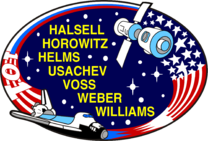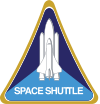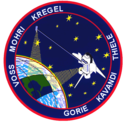STS-101
| Missionsemblem | |||||
|---|---|---|---|---|---|
 | |||||
| Missionsstatistik | |||||
| Missionsnavn: | STS-101 | ||||
| Rumagentur: | NASA | ||||
| Rumfærge: | Atlantis (21) | ||||
| Antal besætningsmedlemmer: | 7 | ||||
| Affyringsrampe: | LC-39A (KSC) | ||||
| Opsendelse: | 19 maj 2000 | ||||
| Landing: | 22 maj 2000 | ||||
| Landet på: | Kennedy Space Center | ||||
| Varighed: | 9 dage, 21 timer | ||||
| Foto af besætningen | |||||
 | |||||
| Navigation | |||||
| |||||
STS-101 (Space Transportation System-101) var rumfærgens Atlantis 21. rumfærge-mission.
Opsendt 19. maj 2000 og vendte tilbage den 29. maj 2000.
Missionen var den tredje mission i opbygningen af Den Internationale Rumstation der endnu ikke var beboet.
En rumvandring blev udført i løbet af missionen der varede i 9 døgn.
Besætning

 James Halsell (kaptajn)
James Halsell (kaptajn)
 Scott Horowitz (pilot)
Scott Horowitz (pilot)
 Jeffrey Williams (1. missionsspecialist)
Jeffrey Williams (1. missionsspecialist)
 James Voss (2. missionsspecialist)
James Voss (2. missionsspecialist)
 Yury Usachev (missionsspecialist) (RKA)
Yury Usachev (missionsspecialist) (RKA)
 Susan Helms (missionsspecialist)
Susan Helms (missionsspecialist)
 Mary Weber (missionsspecialist)
Mary Weber (missionsspecialist)
Hovedartikler:
| Wikimedia Commons har medier relateret til: |
Eksterne henvisninger
- STS-101 NASA (engelsk)
| ||||||||
| ||||||||||||||||||||
Medier brugt på denne side
Space Shuttle Atlantis takes flight on its STS-27 mission on December 2, 1988, 9:30 a.m. EST, utilizing 375,000 pounds thrust produced by its three main engines. The STS-27 was the third classified mission dedicated to the Department of Defense (DoD). After completion of mission, Orbiter Atlantis landed December 6, 1988, 3:36 p.m. PST at Edwards Air Force Base, California.
SVG version of PNG Space Shuttle Logo/Patch.
Astronaut Jeffrey N. Williams, mission specialist, works to attach the newly delivered main boom of the Russian crane (Strela) to its operator post (which had been delivered earlier by mission 2A.1). Astronauts Williams and James S. Voss also secured a United States-built crane that was installed on the station last year; replaced a faulty antenna for one of the station's communications systems; and installed several handrails and a camera cable on the station's exterior.
STS099-(S)-001 (JUNE 1999) STS-99 INSIGNIA -- The crew members designed the flight insignia for the Shuttle Radar Topography Mission (SRTM), the most ambitious Earth mapping mission to date. Two radar antennas, one located in the Shuttle bay and the other located on the end of a 60-meter deployable mast, will be used during the mission to map Earth's features. The goal is to provide a 3-dimensional topographic map of the world's surface up to the Arctic and Antarctic Circles. The clear portion of Earth illustrates the radar beams penetrating its cloudy atmosphere and the unique understanding of the home planet that is provided by space travel. The grid on Earth reflects the mapping character of the SRTM mission. The patch depicts the Space Shuttle Endeavour orbiting Earth in a star spangled universe. The rainbow along Earth's horizon resembles an orbital sunrise. The crew deems the bright colors of the rainbow as symbolic of the bright future ahead because of human beings' venturing into space.
The STS-101 mission patch commemorates the third Space Shuttle flight supporting the assembly of the International Space Station (ISS). This flight's primary tasks are to outfit the ISS and extend its lifetime, and to conduct a spacewalk to install external components in preparation for the docking of the Russian Service Module, Zvezda, and the arrival of the first ISS crew. The Space Shuttle is depicted in an orbit configuration prior to docking with the ISS. The ISS is depicted in the stage of assembly completed for the STS-101 mission, which consists of the United States-built Unity module and the Russian-built Zarya module. The three large stars represent the third ISS mission in the assembly sequence. The elements and colors of the border reflect the flags of the nations represented by the STS-101 crew members, the United States and Russia. The NASA insignia design for Shuttle flights is reserved for use by the astronauts and for other official use as the NASA Administrator may authorize. Public availability has been approved only in the form of illustrations by the various news media. When and if there is any change in this policy, which is not anticipated, it will be publicly announced.
Forfatter/Opretter: By Rei-artur (diskussion · bidrag)., Licens: CC-BY-SA-3.0
Venus/female symbol.
Six astronauts and a Russian cosmonaut take a break from training for the STS-101 mission to pose for a crew portrait. Seated in front are astronauts James D. Halsell (right), mission commander; and Scott J. Horowitz, pilot. Others, from the left, are Mary Ellen Weber, Jeffrey N. Williams, Yury V. Usachev, James S. Voss and Susan J. Helms, all mission specialists. Usachev represents the Russian Space Agency (RSA).
This is the crew patch for the STS-106 mission, which is the first Shuttle flight to the International Space Station since the arrival of its newest component, the Russian-supplied Service Module Zvezda (Russian for star). Zvezda is depicted on the crew patch mated with the already orbiting Node 1 Unity module and Russian-built Functional Cargo Block, called Zarya (sunrise), with a Progress supply vehicle docked to the rear of the Station. The International Space Station is shown in orbit with Earth above as it appears from the perspective of space. The Astronaut Office symbol, a star with three rays of light, provides a connection between the Space Shuttle Atlantis and the Space Station, much the same as the Space Shuttle Program is linked to the International Space Station during its construction and future research operations. Stylized versions of flags from Russia and the United States meet at the Space Station. They symbolize both the cooperation and joint efforts of the two countries during the development and deployment of the permanent outpost in space as well as the close relationship of the American and Russian crew members.
Forfatter/Opretter: Rei-artur (diskussion · bidrag), reshaped by F l a n k e r (talk), Licens: CC-BY-SA-3.0
symbol of Mars. 400 × 400 pixels nominal dimensions, line 45 pixel tick, circle 295 × 295 pixel, not joined with arrow. Colour: red=0 green=0 blue=140.
![]() Vektorgrafikken blev lavet med Inkscape.
Vektorgrafikken blev lavet med Inkscape.
The "glass cockpit" installed on the Space Shuttle: JSC2000-E-10522 (March 2000) -- Eleven new full-color, flat-panel display screens in the Shuttle cockpit replace 32 gauges and electromechanical displays and four cathode-ray tube displays. The new "glass cockpit" is 75 pounds (34 kg) lighter and uses less power than before, and its color displays provide easier pilot recognition of key functions. The new cockpit is expected to be installed on all shuttles in the NASA fleet by 2002, and it sets the stage for the next cockpit improvement planned to fly by 2005: a "smart cockpit" that reduces the pilot's workload during critical periods. During STS-101 Atlantis will fly as the most updated shuttle ever, with more than 100 new modifications incorporated during a ten-month period in 1998 at Boeing's Palmdale, Ca., Shuttle factory.
Note: this is a composite image that was published prior to this cockpit configuration ever flying. The control sticks and seats are missing. The background was photoshopped from a separate image.
















